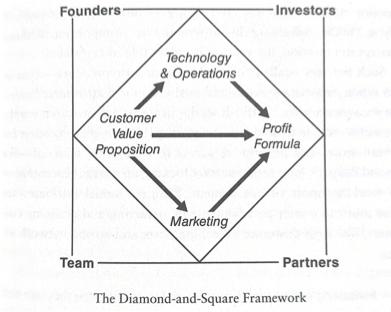Why Startups Fail[Part 1-Intro]
Startup success comes from making difficult trade-offs, good decisions and luck. This book explains those trade-offs and difficult decisions without providing a set recipe anyone can follow.
book by Tom Eisenmann
Amazon link
Book provides a mini MBA for anyone interested in being a founder of a company while using the lens of startup failure.
These are notes I took for myself while reading the book. It is not a review or a comprehensive summary. I'm posting these on my blog in case it might be helpful to someone but I suggest you read the entire book to fully understand the concepts mentioned.
What is failure?
Entrepreneurship - pursuing a novel opportunity while lacking resources
Failure - Did early investors make money?
Risks - Demand risk, Technological risk, Execution risk, Financing Risk
The failure patterns
Early stage
Good Idea, Bad bedfellows**
Getting the right stakeholders, yourself, cofounder, employees, strategic partners, investors
False starts
Starting before customer development
False positives
Early adopters are not mainstream customers
Late stage
VCs lose ⅓ of money in late stage startups.
Speed trap
Saturates the original market.
Success invites rivals
Help wanted
Financing risk
Gaps in senior management
Cascading miracles
Multiple things need to fall in place for a startup to be successful
Likely areas to watch out for:
- Customers change behavior
- New technologies
- Sign up major corporation as partner
- Get regulatory relief or gov. support
- Raise stupendous amount of capital
Handle failure
Pulling plug is not easy
Failure is slow motion
Beware Emotional and psychological effects of failure.
Causes of failure
Misfortune or Mistakes
Horse or Jockey
Jockey- industry experience, general ability, temperament
First time founder and entrepreneurs who previously failed have the same likelihood of success
Catch 22
Resource/opportunity catch-22:
- Cannot pursue opportunity without resources.
- Cannot attract resources until the opportunity is pursued.
Reduce resource requirements
- Resolving - MVP
- Hazards: False start. Build MVP before customer development
- Shifting - Partnering
- Hazzard:Can be difficult to convince partners. Startup will be low priority for partner
- Deferring - staging
- Hazzard: Money from investors who don’t add value in desperation;
- Downplaying opportunity related risks - Storytelling
- Hazzard: Overconfidence can lead missing signals. Self delusion
The diamond and square matrix

Opportunity[diamond]
Customer value proposition
Offer a sustainably differentiated proposition with strong, unmet customer needs.
Moats for sustainable advantage:
- Proprietary assets: patents, brand, access to raw material
- business model attributes: high switching costs and network effects
Decisions:
- Single market or multiple segments
- How much innovation? New business models, new technology, combining existing technology
- Does it require a change to customer behavior?
- Another catch-22: without innovation a product is not differentiated but too much innovation will overshoot customer’s needs
- Low touch or high touch? One size fits all or customized?
- Low touch-
- Can be scaled
- lacks differentiation and cannot command a price premium
- High touch
- Customized solution
- Superior service
- Low touch-
Technology and Operations
Startup must invent, build, deliver and service products.
Decide whether to build or buy.
Marketing
Build it and they will come???
Big bang launch
Premature scaling of marketing and product development is a widespread cause of startup failure
Profit formula
Cannot choose a profit formula independently but choices about three other resource areas determine it.
Unit economics: Gross Profit(revenue-variable costs) per unit sold
Must cover:
- Marketing and overhead costs
- Investments for further growth
- Interest
- Taxes
- Profit
LTV/CAC ratio
Aim for > 3
Break-even point - Gross profit > tax + marketing + fixed costs + new investments
Resources[square]
The four resources should complement one another
Founders
- Industry Experience
- Functional Experience
- Temperament
Entrepreneurs are more likely to be over confident
- fuels resilience,
- may cause taking on too much risk
- attracts talent and capital
Headstrong vs. Tentative
Tentative- underestimate effort required, no passion, throw in towel quickly, cannot attract talent
Headstrong- difficult to work with; defensive; judgemental; does not delegate; ignores advice; inflexible
Team
Hire for attitude or skill?
Attitude-hardworking, passionate, may not be able to solve tough technical challenges
Skill-instant performance boost
Generalist or specialist
Generalist-able to move from task to task
Specialist-might be hard to hire, too quick to embrace solutions that worked previously, might not be able to pivot with company\
Investors
Do we have funder fit?
When to raise?
“Fume date”- when old capital runs out
Investors move in herds to hot sectors
How much to raise?
Greed vs fear
Greed-limit dilutions
Fear-no capital buffer for setbacks\
Too much $$$:
- complacency, laziness and arrogance
- Over hiring
- Missed deadlines - no forcing function
From whom?
Investors can provide advice, coach, network introductions, tips to raise next round.
Misalignment:
- risk/reward trade offs - may force entrepreneurs to take too much risk
- Can they provide additional capital as Bridge funding or investing in the next round?
- Investors need enough capital in their current fund to provide new funding since there might be a conflict of interest to provide the investment from a follow-up fund.
Partners
Partnerships can have a power imbalance.
Big companies take a long time to decide
they may copy the startups technology and strategy
Can drag negotiation to build a bargaining advantage while the startup is running out of cash.
A partnership can pull up a startup by providing cash and brand recognition.